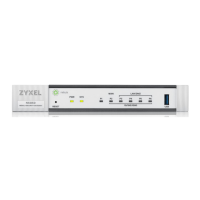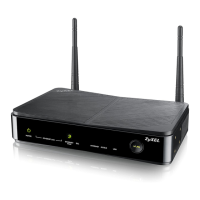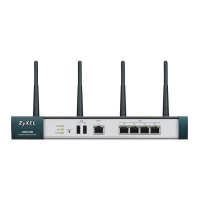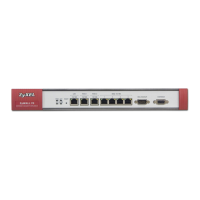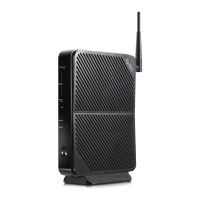Chapter 5 Maintenance
NSG Series User’s Guide
29
Host IP Select a host IP address object for which to capture packets. Select any to capture
packets for all hosts. Select User Defined to be able to enter an IP address.
Host Port This field is configurable when you set the IP Type to any, tcp, or udp. Specify the port
number of traffic to capture.
Misc setting
Continuously capture
and overwrite old ones
Select this to have the NSG keep capturing traffic and overwriting old packet capture
entries when the available storage space runs out.
Captured Packet Files When saving packet captures only to the NSG’s onboard storage, specify a maximum
limit in megabytes for the total combined size of all the capture files on the NSG.
When saving packet captures to a connected USB storage device, specify a maximum
limit in megabytes for each capture file.
Note: If you have existing capture files and have not selected the
Continuously capture and overwrite old ones option, you may need to
set this size larger or delete existing capture files.
The valid range depends on the available onboard/USB storage size. The NSG stops the
capture and generates the capture file when either the file reaches this size or the time
period specified in the Duration field expires.
Split threshold Specify a maximum size limit in megabytes for individual packet capture files. After a
packet capture file reaches this size, the NSG starts another packet capture file.
Duration Set a time limit in seconds for the capture. The NSG stops the capture and generates the
capture file when either this period of time has passed or the file reaches the size
specified in the File Size field. 0 means there is no time limit.
File Suffix Specify text to add to the end of the file name (before the dot and filename extension)
to help you identify the packet capture files. Modifying the file suffix also avoids making
new capture files that overwrite existing files of the same name.
The file name format is “interface name-file suffix.cap”, for example “vlan2-packet-
capture.cap”.
Number of Bytes to
Capture (Per Packet)
Specify the maximum number of bytes to capture per packet. The NSG automatically
truncates packets that exceed this size. As a result, when you view the packet capture
files in a packet analyzer, the actual size of the packets may be larger than the size of
captured packets.
Save data to onboard
storage only
Select this to have the NSG only store packet capture entries on the NSG. The available
storage size is displayed as well.
Note: The NSG reserves some onboard storage space as a buffer.
Save data to USB
storage
Select this to have the NSG store packet capture entries only on a USB storage device
connected to the NSG if the NSG allows this.
Status:
Unused - the connected USB storage device was manually unmounted by using the
Remove Now button or for some reason the NSG cannot mount it.
none - no USB storage device is connected.
service deactivated - USB storage feature is disabled (in Configuration > Object > USB
Storage), so the NSG cannot use a connected USB device to store system logs and other
diagnostic information.
available - you can have the NSG use the USB storage device. The available storage
capacity also displays.
Note: The NSG reserves some USB storage space as a buffer.
Table 15 Maintenance > Diagnostics > Packet Capture (continued)
LABEL DESCRIPTION
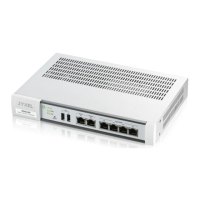
